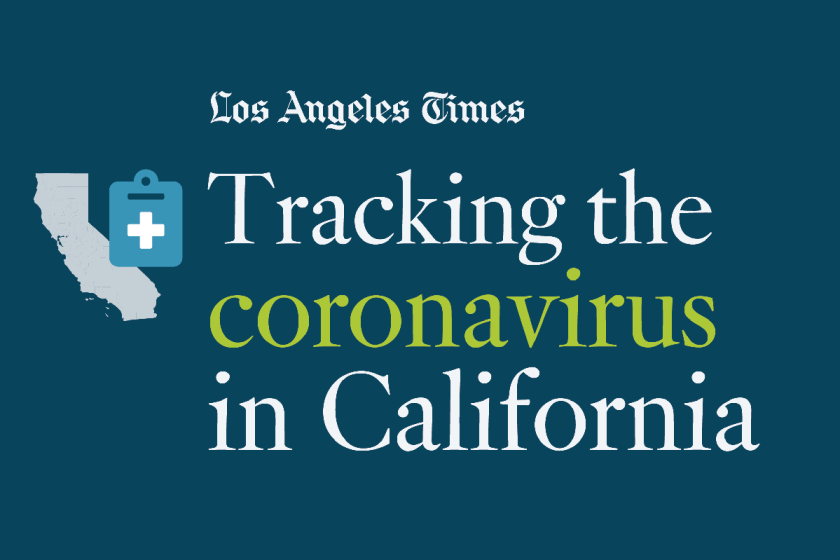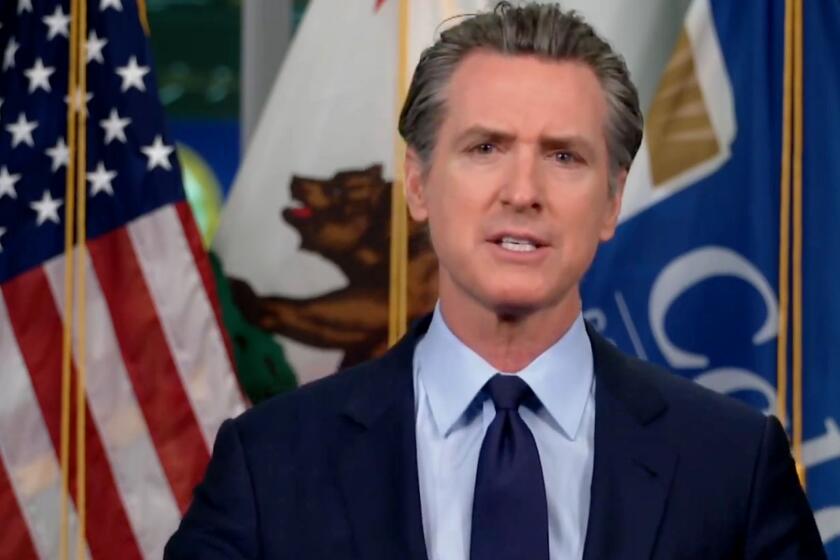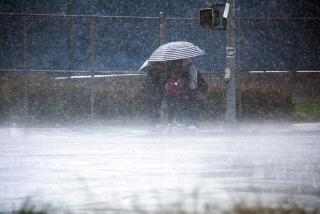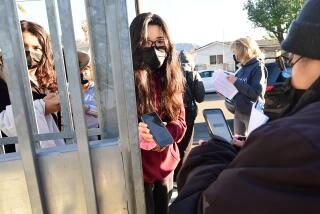Reopening plans stall as 1 in 3 students are testing positive for COVID-19 at some L.A. schools
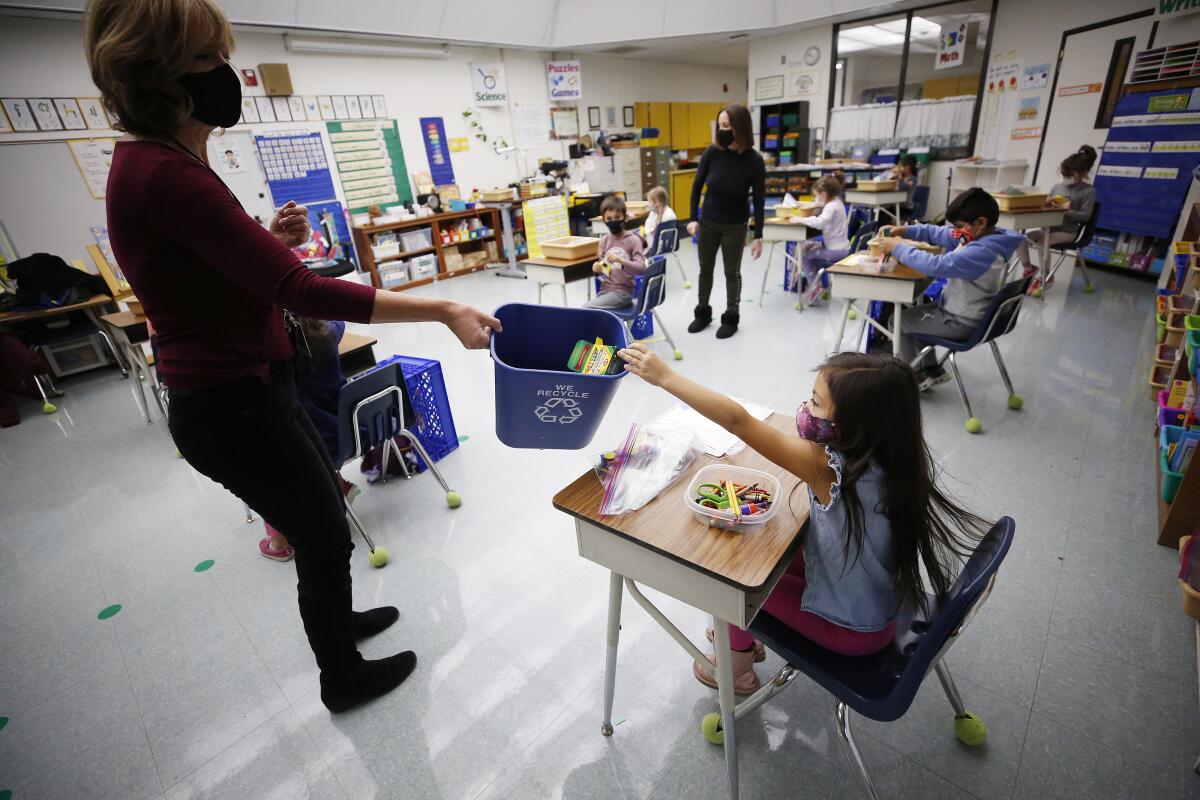
- Share via
With 1 in 3 students testing positive for the coronavirus in some Los Angeles neighborhoods, Gov. Gavin Newsom’s push to reopen campuses is clashing with the reality of a raging pandemic as many school districts opt for January shutdowns and superintendents call for clearer guidance on when it will be safe to unlock their campus doors.
The swift-moving developments come one week after Newsom announced financial help — totaling $2 billion — that would go to elementary schools that reopen as early as next month and later to schools serving older students. Newsom cited the widely acknowledged harms of learning loss and social isolation — especially for Black and Latino students from low-income families — after in-person instruction shut down nearly 10 months ago across the state.
Superintendents from seven of the state’s largest school districts on Wednesday called on Newsom to set a clear and mandated state standard for reopening campuses. They also faulted Newsom’s plan for seeming to rely on funds that would otherwise go toward important existing education programs.
“Our schools stand ready to resume in-person instruction as soon as health conditions are safe and appropriate. But we cannot do it alone,” superintendents from Los Angeles, Long Beach, San Diego, San Francisco, Oakland, Fresno and Sacramento wrote in the letter. “Despite heroic efforts by students, teachers and families, it will take a coordinated effort by all in state and local government to reopen classrooms.”
Amid an unprecedented surge of coronavirus infections that has overwhelmed hospitals — and is widely expected to worsen in coming weeks — many districts, including those in Los Angeles, Pasadena and Claremont, have moved to keep campuses closed for the near future.
“Extraordinarily high case counts of COVID are the barrier to opening schools in the Los Angeles area, and we encourage the governor, the Legislature, state and local authorities to make that job one,” said L.A. schools Supt. Austin Beutner. “Because until the case counts are within any reasonable standard … it’s not possible for schools in Los Angeles to be open, and that’s troubling for all of us.”
L.A. Unified contributed an alarming data point in the letter: Nearly 1 in 3 asymptomatic students from some lower-income communities who sought a coronavirus test at a district-operated site during the week of Dec. 14 turned out to be infected. At the time of the test, the children reported feeling no effects of COVID-19. Asymptomatic carriers can spread the disease to others and might later develop symptoms.
The student positivity rate was 32% in the Maywood, Bell and Cudahy communities, where families have a median income of about $37,000, according to district data, and 25% in Mid-City, where the median income is about $41,000. In contrast, the rate was 4.3% in Venice, with a median income of about $73,000, and 7.1% in the Woodland Hills, West Hills and Tarzana area, with a median income of about $81,000.
Even in higher-income areas, the rate of positive tests among students has spiked, reflecting trends in the wider community. In these conditions, some experts have warned that schools, even if they are operating safely, would run the risk of frequent disruptions — a campus could have to shut down if it has three cases over a 14-day period.
Beutner said it’s the role of state officials and local health departments to do whatever is necessary to bring down community COVID levels, whether it’s a stricter lockdown or something else, to lay the necessary groundwork for campuses to reopen, a goal that he said he shares with the governor “100%.”
Under Newsom’s plan — which is sparse in important details — in the best-case scenario, large numbers of elementary schools across California would open as early as mid-February for students in kindergarten through second grade, with the remainder of elementary students returning as early as March. The governor did not announce a time frame for older students.
But the opposite is happening in many school districts.
The ABC Unified School District, in the Cerritos area of southeast L.A. County, had hoped to reopen campuses using a staggered schedule and small classes in late January.
“It’s not the case now,” said spokesman Scott Smith. A new tentative date has not been set, and a return that recently felt near now “seems like it’s so far away.”
Not long ago, the Pasadena Unified School District had a projected reopening date of Jan. 11, but it went in full reverse last month, even halting in-person services for small groups of students with disabilities and athletic conditioning programs in December.
Ditto for Alhambra Unified, which wanted to avoid whipsawing parents between opening and then closing again, said Toby Gilbert, the district’s head of media relations.
“We will continue those restrictions in this surge upon a surge and revisit it at the end of February,” Gilbert said. “We’re just trying to make sure everybody’s safe, and everyone will need some advance notice” of a pending reopening.
Claremont Unified has pushed back its previously planned Feb. 1 reopening.
The Glendora school district started some in-person classes in the fall semester but struggled to keep campuses open due to required quarantines. In-person instruction is now on hold, to be reevaluated in February, according to a posted district update.
Across the state, some campuses were able to fully reopen when county infection rates were lower, but it has been a patchwork. Now, with infection rates much higher, they can remain open, but other campuses are not allowed to open for the first time.
One apparent exception is Conejo Valley Unified in Ventura County, which says it can open its high schools this month because its other campuses already had opened, and its phased-in approach had been in the works for some time.
In Orange County, just over half of school districts are closed for in-person instruction, according to that county’s Department of Education.
In San Diego County, while 34 of 43 districts had opened for some form of in-person instruction, 79% of public school students remained in online learning through December. The San Diego County Office of Education is currently updating figures for the resumption of school in January.
In L.A. County, campuses were never able to reopen fully, but can operate for kindergarten through second grade under a county-approved waiver — and a small fraction, mostly private schools, have done so. Schools can also bring back up to 25% of enrollment at a given time to serve students with special needs, such as those learning English or those with disabilities.
Las Virgenes Unified, which straddles the border of L.A. and Ventura counties, is using the waivers at all of its elementary schools and took advantage of the 25% rule to bring back third-graders.
“We are staying the course,” said Supt. Dan Stepenosky. “Of course, anything can change, and we’re monitoring the numbers closely.”
Also in that camp is El Segundo Unified, a small suburban coastal district south of the airport.
“I can say with certainty that the health and safety protocols are working,” said Supt. Melissa Moore.
Palos Verdes Peninsula Unified had been ramping up, with almost all K-2 classes back, preschools open, outdoor athletic conditioning in progress, some classes in session for students with disabilities and on-campus online-learning pods at middle and high schools. All these activities are allowed in L.A. County with the proper safety measures.
The district, however, has paused everything for two weeks, said Supt. Alexander Cherniss, because of problems caused when the county ordered a 10-day quarantine for returning travelers in late December — after many district staff members already had left the area over winter break.
Burbank Unified and Santa Monica-Malibu Unified are among the school systems that will remain primarily in distance learning for the remainder of the school year. L.A. Unified, the nation’s second-largest school system, hasn’t made a decision, but it shut down all in-person services — which were reaching less than 1% of students — in December. Long Beach hopes it can hold to a March 1 reopening timetable.
Beverly Hills Unified has a waiver for an elementary school but is holding off using it.
“This is a very emotional and polarizing situation, because people feel very differently on how and when schools will reopen,” said Supt. Michael Bregy.
The school district created its own reopening standard of an average daily rate of 10 cases per 100,000 people. The state’s new threshold rate is 28 cases per 100,000; the state’s prior standard had been 7 cases per 100,000.
“Weighing the ability and sustainability to keep our schools open, I think 28 is too high,” Bregy said.
California students in kindergarten through second grade would be allowed back on campus when pandemic conditions improved under a proposal announced Wednesday.
If conditions improve quickly, Bregy added, students will be able to return to campuses, with the youngest students first.
He said Beverly Hills Unified hopes it would be allowed to host vaccination clinics for staff and the community. Similarly, the superintendents of the large districts who wrote to the governor also advocated for establishing schools as vaccination centers.
“We need to do everything we can” to be part of the solution, Bregy said.
More to Read
Sign up for Essential California
The most important California stories and recommendations in your inbox every morning.
You may occasionally receive promotional content from the Los Angeles Times.
